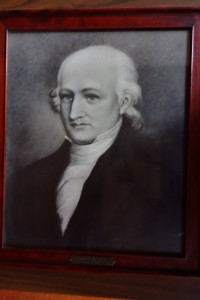Challenges of Early Industry in Lenox
The challenges of early rural industry are illustrated by the number of failed attempts to get a working operation going in Lenox Dale (then known as Lenox Furnace).
To review, John Larrabee had been granted 500 acres encompassing most of modern Lenox Dale in 1739. Despite the potential for industrialization presented by the Housatonic River, wars (French and Indian and then the American Revolution) prohibited most economic activity.
The water power would have been of interest for wood planing, grain grinding, fulling or other long- standing mill technologies. The water power to drive the fans and other devices need for creation of iron would have made the even more appealing after a rich vein of iron ore was found running under Lenox, Richmond, and West Stockbridge.
Iron Industry Finally on its Feet 1788
Nonetheless, there clearly was a great challenge in accumulating the capital and expertise needed. To illustrate, here’s a list the transactions (per the unpublished George Tucker manuscript) that took place before the iron manufacturing operation got on its feet – 1788 or so.
- 1760 – Larrabee sells to Charles Goodrich of Pittsfield
- 1774 – Map shows Larrabee grant divided between Samuel Northrup, Elijah Northrup, Thomas Landers, Elijah Gates, Thomas Gates, James Howland and Elisha Percival (not clear whether they owned or rented given entry below – or perhaps they didn’t own the river front??)
- 1783 – First record of a “furnace” on this property
- 1783 – Job Gilbert leased the “furnace” property for one year to Elisha Martingale and Ephraim Hollister
- Job Gilbert of Bristol, MA was described as someone who understood the iron ore business
- 1783 – James Perry bought coal for the furnace; and took to a portion of the iron ore under Bald Mountain (held by Lemuel Collins at the time)
- 1786 – Clearly Gilbert was having difficulty holding on to enough capital to keep the iron works afloat and William Walker organized a group of 46 local subscribers to bail him out (some of whom would be repaid in hollow ware)
-

William Walker 1788 – Gilbert sold his interest in the iron works to William Walker; Walker partnered with Joseph Goodwin.
- 1788 – Partnership divided: Iron Works and Furnace to Goodwin, saw, oil, grist mill water rights and carding machine to Walker (apparently other small manufacturing investments had been made along with iron making capabilities).
- 1813 – Walker sold his portion to his son (William P. Walker) and his daughter’s husband (Dr. Charles Worthington).
Iron making prospered mid 19th century – particular in meeting the demand for arms during the Civil War. By 1877, coke, started to be mined in Pennsylvania – presenting a cheaper, hotter alternative to the charcoal used at Lenox Furnace.
However, in addition to the continued use of water power for the saw mill, another manufacturing venture, glass making, would make use of the water power starting in the 1850’s.
